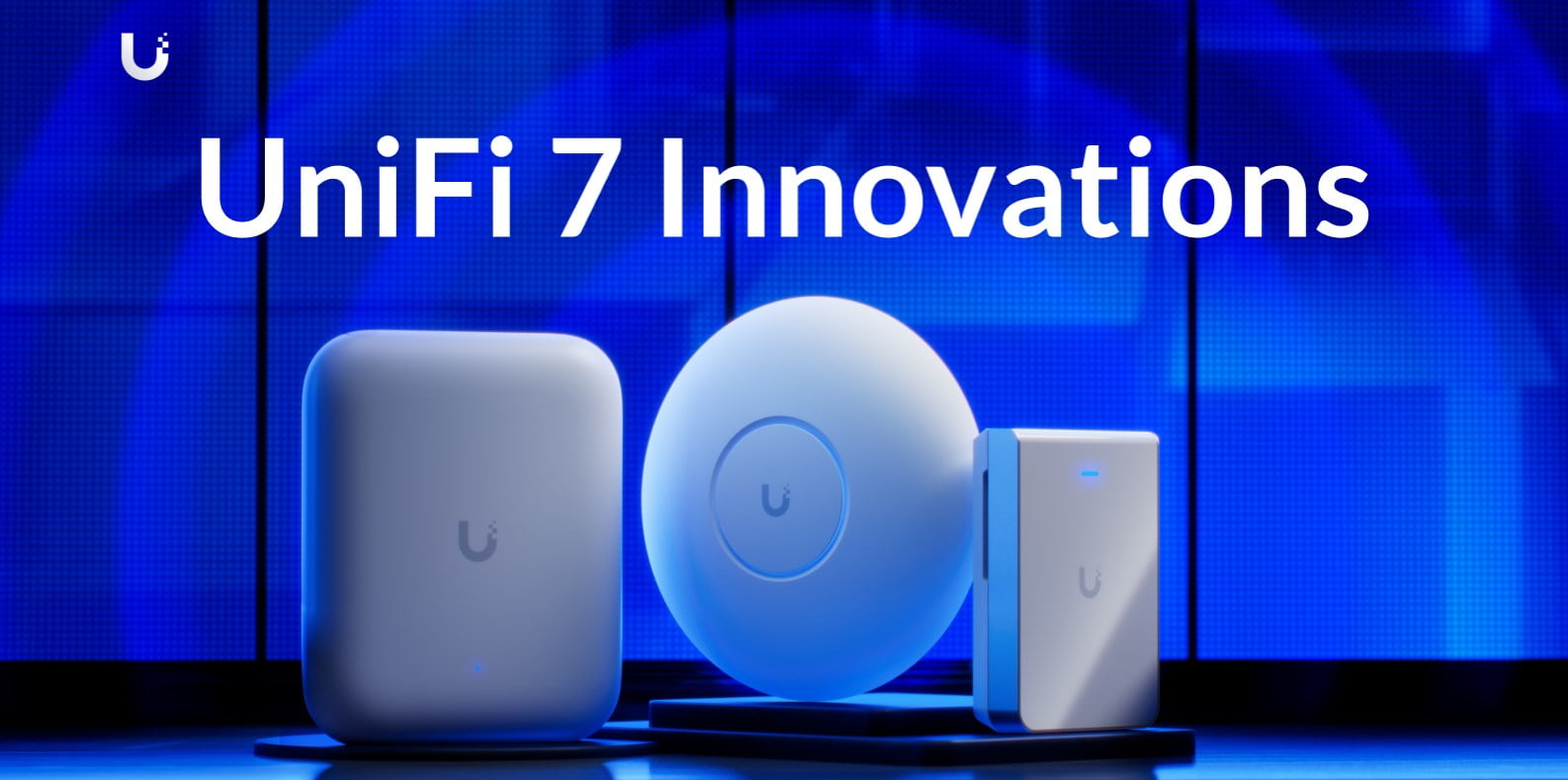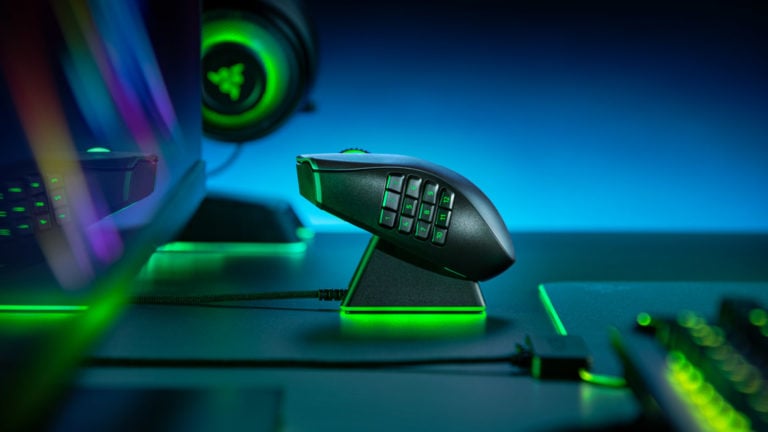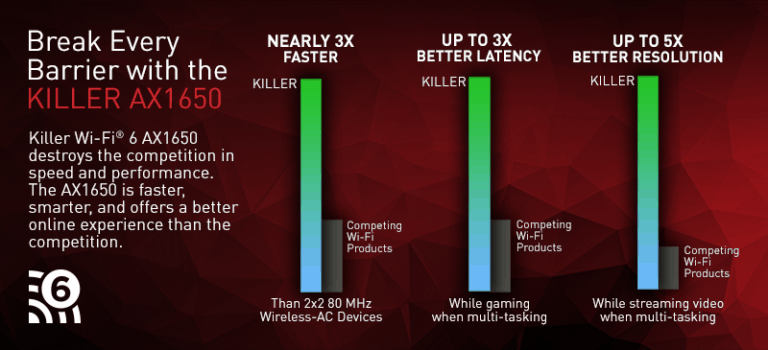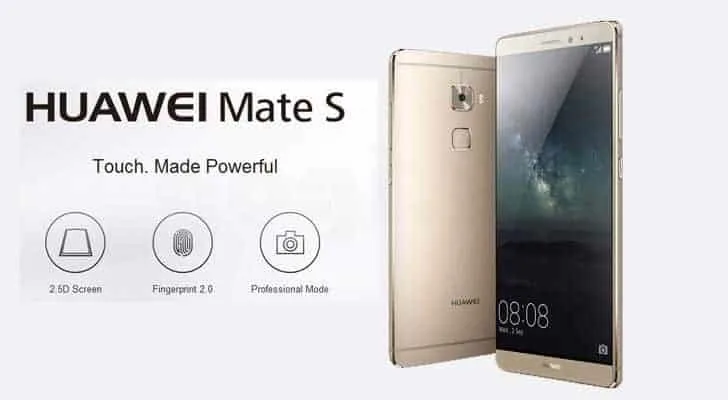Any links to online stores should be assumed to be affiliates. The company or PR agency provides all or most review samples. They have no control over my content, and I provide my honest opinion.
Back in January, Ubiquiti announced its first WiFi 7 access point. At the time, it was the first affordable WiFi 7 access point to launch and still remains the most affordable even though there are a growing number of affordable WiFi 7 access points.
In my review of the U7 Pro, I found it was superb and fractionally outperformed the Zyxel NWA130BE.
Now, Ubiquiti has announced three new access points. There is the U7 Pro Wall, which benefits from an additional four-gigabit ports, allowing it to work as a switch, and the U7 Outdoor, which is IPX6 rated and comes with additional external antennas but not 6GHz as it is designed for outdoor use.
Finally, there is the flagship model, the UniFi 7 Pro Max, which bumps up the 5GHz band to 4×4 MIIMO, has an additional 1GbE port and more.
Specification Comparison
| Unifi 7 Pro Max | Unifi U7 Pro Wall | Unifi U7 Outdoor | Unifi 7 Pro | |
|---|---|---|---|---|
| Mechanical | ||||
| Dimensions | Ø206 x 46 mm (Ø8.1 x 1.8″) | 150 x 103 x 36 mm (5.9 x 4.1 x 1.4″) | 170 x 208 x 54.5 mm (6.7 x 8.2 x 2.1″) | Ø206 x 46 mm (Ø8.1 x 1.8″) |
| Weight | 680 g (1.5 lb) | 580 g (1.3 lb) | 1.2 kg (2.6 lb) | 680 g (1.5 lb) |
| Enclosure material | Polycarbonate, aluminum | Polycarbonate, aluminum | UV-stabilized polycarbonate, aluminum alloy IPX6 | Polycarbonate, metal |
| Mount material | Stainless steel (SUS304), galvanized steel (SGCC) | Aluminum | Polycarbonate, SGCC steel Wind survivability 25–60 mm (1–2.36″) on pipe outer diameter 74.6 N at 200 km/h (16.8 lbf at 125 mph) | Stainless steel (SUS304), galvanized steel (SGCC) |
| Hardware | ||||
| Networking interface | (1) 1/2.5 GbE RJ45 port | (1) 1/2.5 GbE RJ45 port | (1) 1/2.5 GbE RJ45 port | (1) 1/2.5 GbE RJ45 port |
| Management interface | Ethernet | Ethernet | Ethernet | Ethernet |
| Power method | PoE+ | PoE+ | PoE+ | PoE+ |
| Power supply | UniFi PoE switch | UniFi PoE switch | UniFi PoE Switch | UniFi PoE switch |
| Supported voltage range | 44—57V DC | 44—57V DC | 42.5—57V DC | 44—57V DC |
| Max. power consumption | 22W | 22W | 19W | 21W |
| Max. TX power | ||||
| 2.4 GHz | 23 dBm | 22 dBm | 23 dBm | 22 dBm |
| 5 GHz | 29 dBm | 26 dBm | 26 dBm | 26 dBm |
| 6 GHz | 23 dBm | 23 dBm | – | 23 dBm |
| MIMO | ||||
| 2.4 GHz | 2 x 2 | 2 x 2 | 2 x 2 | 2 x 2 |
| 5 GHz | 4 x 4 | 2 x 2 | 2 x 2 | 2 x 2 |
| 6 GHz | 2 x 2 | 2 x 2 | – | 2 x 2 |
| Throughput rate | ||||
| 2.4 GHz | 688 Mbps | 688 Mbps | 688 Mbps | 688 Mbps |
| 5 GHz | 8648 Mbps | 4324 Mbps | 4324 Mbps | 2882 Mbps |
| 6 GHz | 5765 Mbps | 5764 Mbps | – | 5765 Mbps |
| Antenna gain | ||||
| 2.4 GHz | 4 dBi | 4 dBi | Directional internal: 8 dBi / External omni: 3 dBi | 4 dBi |
| 5 GHz | 6 dBi | 5 dBi | Directional internal: 12.5 dBi / External omni: 4 dBi | 6 dBi |
| 6 GHz | 5.9 dBi | 5.8 dBi | – | 5.8 dBi |
| LEDs | White/blue | White/blue | White/blue | |
| Button | Factory reset | Factory reset | Factory reset | |
| Mounting | Wall, ceiling (Included) | Wall (Included) Table stand, flush mount (Optional) | Wall, ceiling, pole (Included) | Wall/ceiling (Included) |
| Ambient operating temperature | -30 to 60° C (-22 to 140° F) | -30 to 60° C (-22 to 140° F) | -30 to 60° C (-22 to 140° F) | -30 to 60° C (-22 to 140° F) |
| Ambient operating humidity | 5 to 95% noncondensing | 5 to 95% noncondensing | 5 to 95% noncondensing | 5 to 95% noncondensing |
| Certifications | CE, FCC, IC | CE, FCC, IC | CE, FCC, IC | CE, FCC, IC |
| Software | ||||
| WiFi standards | 802.11a/b/g/n/ac/ax/be | 802.11a/b/g/n/ac/ax/be | 802.11a/b/g/n/ac/ax/be | 802.11a/b/g/n/ac/ax/be |
| Wireless security | WPA-PSK, WPA-Enterprise (WPA/WPA2/WPA3/PPSK) | WPA-PSK, WPA-Enterprise (WPA/WPA2/WPA3/PPSK) | WPA-PSK, WPA-Enterprise (WPA/WPA2/WPA3/PPSK) | WPA-PSK, WPA-Enterprise (WPA/WPA2/WPA3/PPSK) |
| BSSID | 8 per radio | 8 per radio | 8 per radio | 8 per radio |
| VLAN | 802.1Q | 802.1Q | 802.1Q | 802.1Q |
| Advanced QoS | Per-user rate limiting | Per-user rate limiting | Per-user rate limiting | Per-user rate limiting |
| Guest traffic isolation | Supported | Supported | Supported | Supported |
| Concurrent clients | 500+ | 300+ | 200+ | 300+ |
| Supported Data Rates | ||||
| 802.11a | 6, 9, 12, 18, 24, 36, 48, 54 Mbps | 6, 9, 12, 18, 24, 36, 48, 54 Mbps | 6, 9, 12, 18, 24, 36, 48, 54 Mbps | 6, 9, 12, 18, 24, 36, 48, 54 Mbps |
| 802.11b | 1, 2, 5.5, 11 Mbps | 1, 2, 5.5, 11 Mbps | 1, 2, 5.5, 11 Mbps | 1, 2, 5.5, 11 Mbps |
| 802.11g | 6, 9, 12, 18, 24, 36, 48, 54 Mbps | 6, 9, 12, 18, 24, 36, 48, 54 Mbps | 6, 9, 12, 18, 24, 36, 48, 54 Mbps | 6, 9, 12, 18, 24, 36, 48, 54 Mbps |
| 802.11n | 6.5 Mbps to 300 Mbps (MCS0 – MCS15, HT 20/40) | 6.5 Mbps to 300 Mbps (MCS0 – MCS15, HT 20/40) | 6.5 Mbps to 300 Mbps (MCS0 – MCS15, HT 20/40) | 6.5 Mbps to 300 Mbps (MCS0 – MCS15, HT 20/40) |
| 802.11ac (WiFi 5) | 6.5 Mbps to 1.7 Gbps (MCS0 – MCS9 NSS1/2, VHT 20/40/80/160) | 6.5 Mbps to 1.7 Gbps (MCS0 – MCS9 NSS1/2, VHT 20/40/80/160) | 6.5 Mbps to 1.7 Gbps (MCS0 – MCS9 NSS1/2, VHT 20/40/80/160) | 6.5 Mbps to 1.7 Gbps (MCS0 – MCS9 NSS1/2, VHT 20/40/80/160) |
| 802.11ax (WiFi 6/6E) | 7.3 Mbps to 2.4 Gbps (MCS0 – MCS11 NSS1/2, HE 20/40/80/160) | 7.3 Mbps to 2.4 Gbps (MCS0 – MCS11 NSS1/2, HE 20/40/80/160) | 7.3 Mbps to 2.4 Gbps (MCS0 – MCS11 NSS1/2, HE 20/40/80/160) | 7.3 Mbps to 2.4 Gbps (MCS0 – MCS11 NSS1/2, HE 20/40/80/160) |
| 802.11be (WiFi 7) | 7.3 Mbps to 5.7 Gbps (MCS0 – MCS13 NSS1/2, EHT 20/40/80/160/240/320) | 7.3 Mbps to 5.7 Gbps (MCS0 – MCS13 NSS1/2, EHT 20/40/80/160/240/320) | 7.3 Mbps to 4.3 Gbps (MCS0 – MCS13 NSS1/2, EHT 20/40/80/160/240) | 7.3 Mbps to 5.7 Gbps (MCS0 – MCS13 NSS1/2, EHT 20/40/80/160/240/320) |
| Application Requirements | ||||
| UniFi Network | Version 8.2.93 and later | Version 8.1 and later | Version 8.0.26 and later | |
| Version 3.2 and later | Version 3.2 and later | |||
| Price | $279 | $199 | $199 | $189 |
UniFi 7 Pro Max
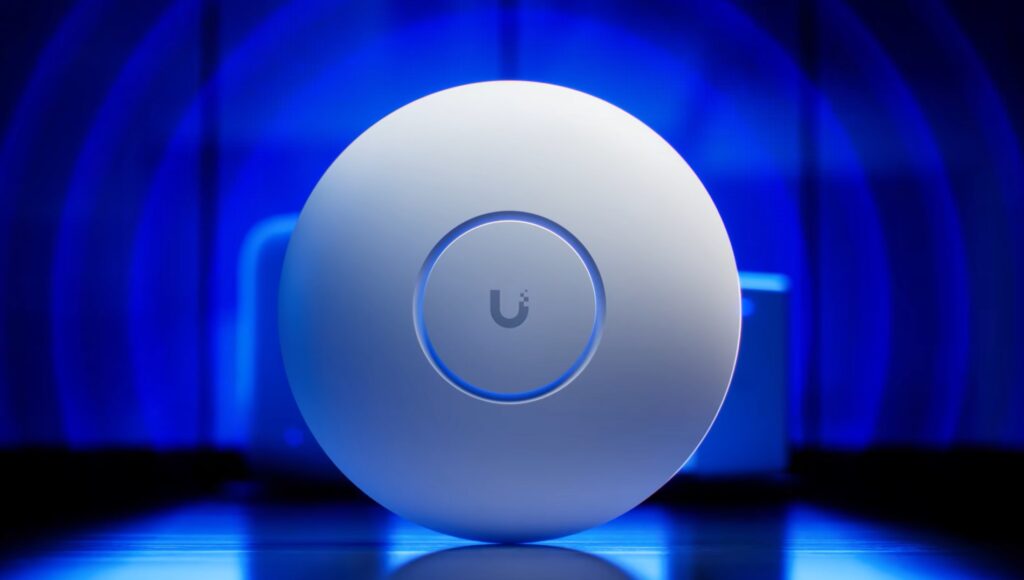
The UniFi 7 Pro Max is the flagship model in Ubiquiti’s WiFi 7 access point lineup. It boasts impressive specifications, making it suitable for demanding environments such as large offices, event venues, and high-density deployments.
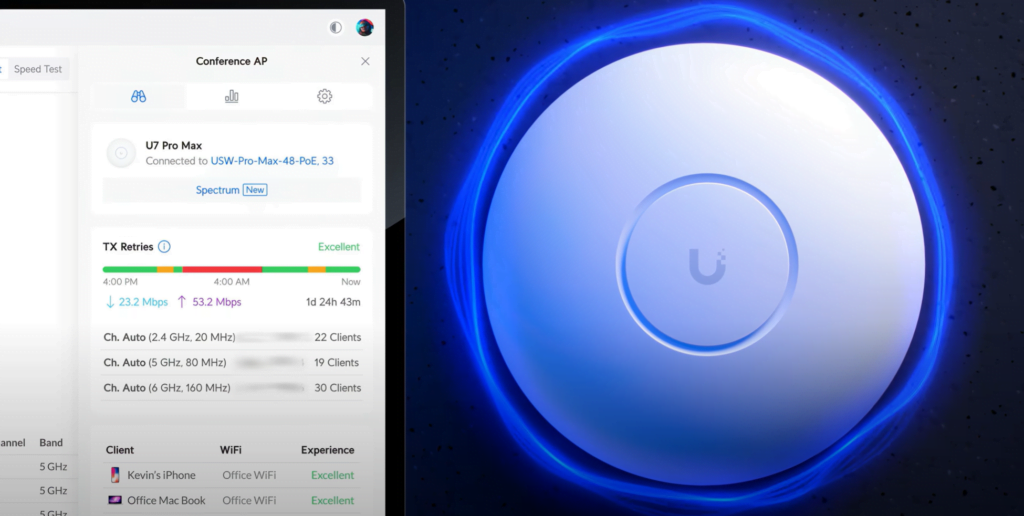
The UniFi 7 Pro Max supports the latest WiFi 7 standard (802.11be), enabling it to achieve combined throughput rates of up to 15.1 Gbps across the 2.4 GHz, 5 GHz, and 6 GHz bands. The 4×4 MIMO configuration on the 5 GHz band allows for enhanced performance and capacity, making it ideal for high-bandwidth applications like video streaming and virtual reality.
No 4×4 6GHz or 10GbE
It may seem odd that Ubiquiti has launched a flagship access point without flagship specs. The access point only has 4×4 on the 5GHz band and lacks 10GbE, so the throughput will always be capped at 2500Gbps.
While this may be disappointing, you need to factor in the cost. This is only $279, the cheapest WiFI 7 AP with 10GbE is the EnGenius ECW536.
UniFi U7 Pro Wall
The UniFi U7 Pro Wall is a wall-mounted access point designed for seamless integration into existing network infrastructure. Its compact form factor and versatile mounting options make it an excellent choice for hotel rooms, classrooms, and office spaces.
The UniFi U7 Pro Wall offers a combined throughput of up to 10.8 Gbps, ensuring fast and reliable connectivity for multiple devices. The access point supports WiFi 7 (802.11be) and is backwards compatible with older WiFi standards, allowing for seamless integration with existing devices.
The overall specification is basically the same as the Unifi 7 Pro, but it also has an additional four-gigabit ethernet ports, allowing you to use it as a switch.
UniFi U7 Outdoor
The UniFi U7 Outdoor supports WiFi 7 (802.11be) and delivers a combined throughput of up to 5 Gbps. It features both directional and omnidirectional antennas, allowing for targeted coverage in specific areas or wide-area coverage, depending on the deployment requirements. The access point is rated IPX6 for protection against heavy rain, snow, and dust, ensuring reliable operation in harsh outdoor conditions.
The AP has a UV-stabilized polycarbonate and aluminium alloy enclosure. It can be mounted on walls, ceilings, or poles using the included mounting kit, providing flexibility in installation. The access point is designed to withstand extreme temperatures ranging from -30°C to 60°C and features enhanced wind survivability, making it suitable for various outdoor environments, including public spaces, transportation hubs, and industrial facilities.
You may wonder why this lacks 6GHz, and that’s because of regulatory requirements; 6GHz is not supposed to be used on outdoor access points.
UniFi 7 Enterprise
It may be disappointing that the UniFi 7 Pro Max lacks 4×4 MIMO for all bands and 10GbE, but Ubiquiti seems to know its target market. All their products have been attractively priced compared to options from other brands, and they are incredibly popular with enthusiasts using them at home and small businesses.
One likely scenario is that Ubiquiti will eventually launch another WiFi 7 access point that will be a true flagship device.
If and when that gets launched is another question.
Comparison with Other Flagship WiFi 7 Access Points
I have done a comparison of high-performance WiFi 7 access points, which all have 4×4 MIMO for each band and at least one 10GbE port.
The EnGenius ECW536 is a stand-out product due to its low price of $500 and dual 10GbE ports.
The Ruijie RG-RAP73HD has the most impressive specifications, but it costs nearly £1000.
Overall
The UniFi 7 Pro Max is an interesting access point, it has higher capacity on the 5GHz, has a higher TX power output and can do real-time spectral analysis for enhanced channel selection.
This improved spec vs the U7 Pro means it costs $90 more. That’s still quite affordable as far as WiFi 7 products go.
I am not sure home users or small businesses would benefit greatly from this upgrade, but it will certainly be useful for larger deployments.
I am James, a UK-based tech enthusiast and the Editor and Owner of Mighty Gadget, which I’ve proudly run since 2007. Passionate about all things technology, my expertise spans from computers and networking to mobile, wearables, and smart home devices.
As a fitness fanatic who loves running and cycling, I also have a keen interest in fitness-related technology, and I take every opportunity to cover this niche on my blog. My diverse interests allow me to bring a unique perspective to tech blogging, merging lifestyle, fitness, and the latest tech trends.
In my academic pursuits, I earned a BSc in Information Systems Design from UCLAN, before advancing my learning with a Master’s Degree in Computing. This advanced study also included Cisco CCNA accreditation, further demonstrating my commitment to understanding and staying ahead of the technology curve.
I’m proud to share that Vuelio has consistently ranked Mighty Gadget as one of the top technology blogs in the UK. With my dedication to technology and drive to share my insights, I aim to continue providing my readers with engaging and informative content.

